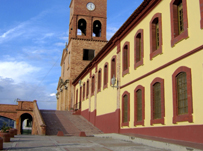Spanish Language Guide (1): History, Usage & Variations of Spanish in the World
Thursday, 28th June 2007

Sarah Gooding, Editor at Cactus, takes a look at the Spanish language
Spanish in the World Today
With some 400 million native speakers worldwide, and another 100 million speaking it as a second language, there can be no doubting the importance of Spanish as a global language.
In native speaker terms, only Mandarin Chinese has more speakers, yet it’s Spanish that dominates when it comes to the number of countries where it is the official language. Spanish is the official language of 21 countries - Spain, most countries across Central and South America, and Equatorial Guinea in Central Africa – and it is also one of the six official languages of the United Nations. Mexico boasts the largest number of Spanish speakers, at some 100 million, while in the US Spanish is the second-most spoken language (and the most popular language studied as a second language), after English.
On a business level, knowledge of Spanish opens the door to a vast number of people and economies. Latinos being the communicative and welcoming people that they are, anyone doing business with a Hispanic nation will invariably find relationships enhanced with some knowledge of the language. Outside Hispanic nations, Spanish-speaking communities within the world’s largest economy, the US, are valuable resources; the language is also important in Brazil, given its proximity to Spanish-speaking neighbours and membership of the Mercosur regional trade agreement.
History of Spanish
Spanish is a Romance language, meaning that it is one of a family of languages that descends from Latin, the language of ancient Rome. Other languages that have their roots in Latin include French, Italian, Catalan and Portuguese, and it follows that there are striking similarities between each of these, in their sounds, structure and vocabulary.
Spanish originated in northern Spain and soon spread across the rest of the country as the main language of government and commerce. From the outset it was heavily influenced by Arabic, due to the Islamic occupation of Spain between the 7th-15th centuries AD. Today, a number of Spanish words and names still reflect their Arab past: berenjena (aubergine), aceite (oil) and Alhambra (literally ‘the red one’ - the full name is Qal’at al-Hambra, meaning The Red Fortress).
It was the subsequent conquest and colonisation by the Spanish Empire, in the 15th-19th centuries, of the Americas, Africa and parts of Asia, that took the language further afield. Some of these places may have since cut ties with their Spanish roots, but the language has survived and flourished in many, adopting its own distinct personality from place to place with diverse vocabulary and accents.
Variations of Spanish - Spain
Being spoken in so many countries and by so many people worldwide, Spanish is something of a special case when it comes to varieties of the language – there are lots! You shouldn’t let this put you off though; the great thing about Spanish is that the variations of language and accent are never so much that one variety of Spanish will not be understood elsewhere. For example, if you learn Spanish in Mexico, you will still be able to speak it and understand it in Spain. And if you learn Spanish in Spain, this will still stand you in good stead to set off round South America for a year. You just need to be aware that there will be regional differences in-country and between countries, and whether you choose to adapt your Spanish to your new surroundings is completely up to you.
Within Spain itself, there are a handful of local dialects, or regional varieties of a language, which you should be aware of if travelling to these places:
- Basque (euskara): spoken in the autonomous community of the Basque country, on both sides of the Spanish-French Pyrenean border. Basque is very unlike Spanish and a difficult language to master; it has significant political and cultural power. Total speakers: 1 million.
- Catalan: the official language of Catalunya, of which Barcelona is the state capital, and of other regions including Valencia, the Balearic Islands and Andorra. Total speakers: 9 million. Catalan is a Romance language and is closely related to French, Italian and Provencal.
- Castilian (castellano): standard Spanish spoken in Spain, as opposed to the other languages/dialects.
- Galician (galego): spoken in Galicia in north-west Spain. Its proximity to Portugal makes it a language close to both Spanish and Portuguese. Total speakers: 3-4 million.
- Valencian (valenciano): a version of Catalan, spoken around Valencia in eastern Spain. Total speakers: 9 million.
- Other: other Spanish languages include Andalusian, Canarian, Extremaduran and Murcian Spanish.
Variations of Spanish - Latin America
The great thing about Spanish is that although there are natural differences in the language from country to country, they will not be prohibitive to your comprehension and ability to get around. You may just need to tune your ear in initially, but then again most of us find we need to do that after It’s also worth noting that any differences will be more notable in spoken Spanish, usually less so when written.
It would be impossible to list all the variations found in Spanish, but one of most obvious differences between the Spanish of Spain and the Spanish of Latin America is the pronunciation of ‘s’ and ‘z’. In Spain, these letters are usually pronounced like the ‘th’ of ‘thin’; in Latin America, they are usually pronounced with an ‘s’ like ‘soft’.
The pronunciation of the ‘s’, in turn, is often dropped in some varieties of the language, so ‘está’ may sound more like ‘etá’ – equally, the ‘d’ is sometimes dropped, to make words ending in ‘-ado’ sound like ‘-ao’. Such dropping of letters can make the words sound more like they are running into each other – not always welcome when you’re learning and finding the language fast enough anyway! Your ear should soon become used to it though. I remember visiting the north coast of Colombia where, in true laid-back Caribbean style, many of the letters are dropped in the middle and at the end of words. I was soon falling into their habits and doing the same myself – after all, if you can’t beat ‘em, join ‘em!
Another clear difference in spoken Spanish is the pronunciation of ‘ll’ and ‘y’. In Argentina especially, these letters are heard as a ‘sh’ sound, as in ‘sure’, or like ‘z’, as in ‘azure’. Argentine Spanish also has another pecularity: the ‘tú’ form becomes ‘vos’, with the ending of the verb changing slightly. (Interestingly, going back to linguistic roots, this use of ‘vos’ echoes the Portuguese ‘você’, the French ‘vous’ and the Italian ‘voi’.) If you want to sound like a local then this is one idiosyncrasy you should probably get used to: ‘vos sos mi amigo’ and ‘cuantos años tenés’ are examples of its usage. Finally, it’s worth nothing that the use of ‘vos’ is not exclusive to Argentina – it is most widely used here, but also appears in varying degrees in other parts of Central and South America.
Another marked grammatical difference is that the plural of ‘tú’ (you, singular) becomes ‘vosotros’ from Spain and ‘ustedes’ in Latin America.
Within Latin America itself, of course, pronunciation and vocabulary will vary from country to country, but no more so than you would expect English to change from the UK to Ireland or Canada to the US.
Where should I learn Spanish?
If you are a beginner and yet to embark on the thrilling journey that is learning Spanish, you may be wondering where best to learn it. As described before, the Spanish you learn in one place can really be taken anywhere you choose. Having said that, there are places where the Spanish they speak is said to be particularly clear and ‘neutral’: Mexico and Colombia in South America, and the region of Castilla in Spain (home to the beautiful university city of Salamanca, a popular language learning destination). By contrast, if you learn Spanish somewhere like Cuba, you will come away with a very distinct accent, as you will if you study somewhere like Argentina (for reasons described above). No version of Spanish is really ‘better’ than another – it is often purely down to taste, and where and why you wish to use it.
Difficulty of Spanish
Is Spanish difficult to learn? At first, any language can seem difficult to learn, especially if you don’t have that so-called ‘linguistic streak’ in you. Like any new skill, you need to put in the time and practice. Yet, when compared with other worldwide languages, Spanish is one of the easier languages to learn – which is great news, given the use you’ll get out of it.
Languages like Russian and Chinese are inherently difficult to learn, given that you invariably need to learn a new alphabet before you even start out. Spanish, however, has the advantage that it actually sounds how it looks, and vice versa - what you see is what you get. You may need to learn when to use the accents, but at the end of the day these help you to get the pronunciation right: you can usually be sure to accentuate the penultimate syllable of a word, unless there is an accent that tells you otherwise.
One stumbling block that usually catches foreign learners is the Spanish ‘r’, which is rolled. They say that you can either roll your r’s or not – in the same way that you can either roll your tongue or not – but with perseverence you should be able to work on this. Words like ‘guerra’ and ‘Navarra’ can be a linguistic nightmare otherwise. Another peculiarity to Spanish is the ‘j’, or ‘jota’: this sound is produced in the throat, like the Scottish word ‘loch’, to produce something akin to a rolled ‘h’.
With its roots in Latin, being a Romance language, you will find Spanish even easier if you already speak a language like French, Italian or Portuguese, where many of the words and grammatical structures are similar. Tenses like the Subjunctive (which doesn’t exist in English) will make more sense, and the gender of words (masculine or feminine) will come more naturally.
However you pick it up, study of the Spanish language is invariably fun and stimulating. It is immediately rewarding as you can learn a few things in a short amount of time, and any study of the language will naturally reflect the fascinating and vibrant cultures of the Spanish-speaking world. Enough of us telling you about it, though - much better to get out there and explore it yourself. ¡Buena suerte!
Tags: castellano, romance language, latin america, catalan, basque, language learning, language, colombia, mexico, argentina, cuba, spain, culture, spanish, guide
Posted by Editor 2007-06 under Language guides,
Permalink
